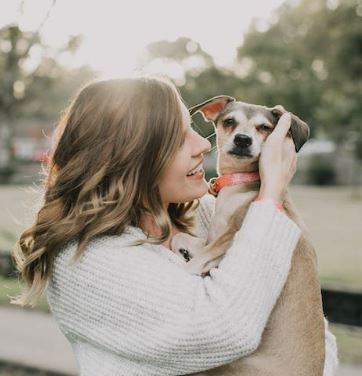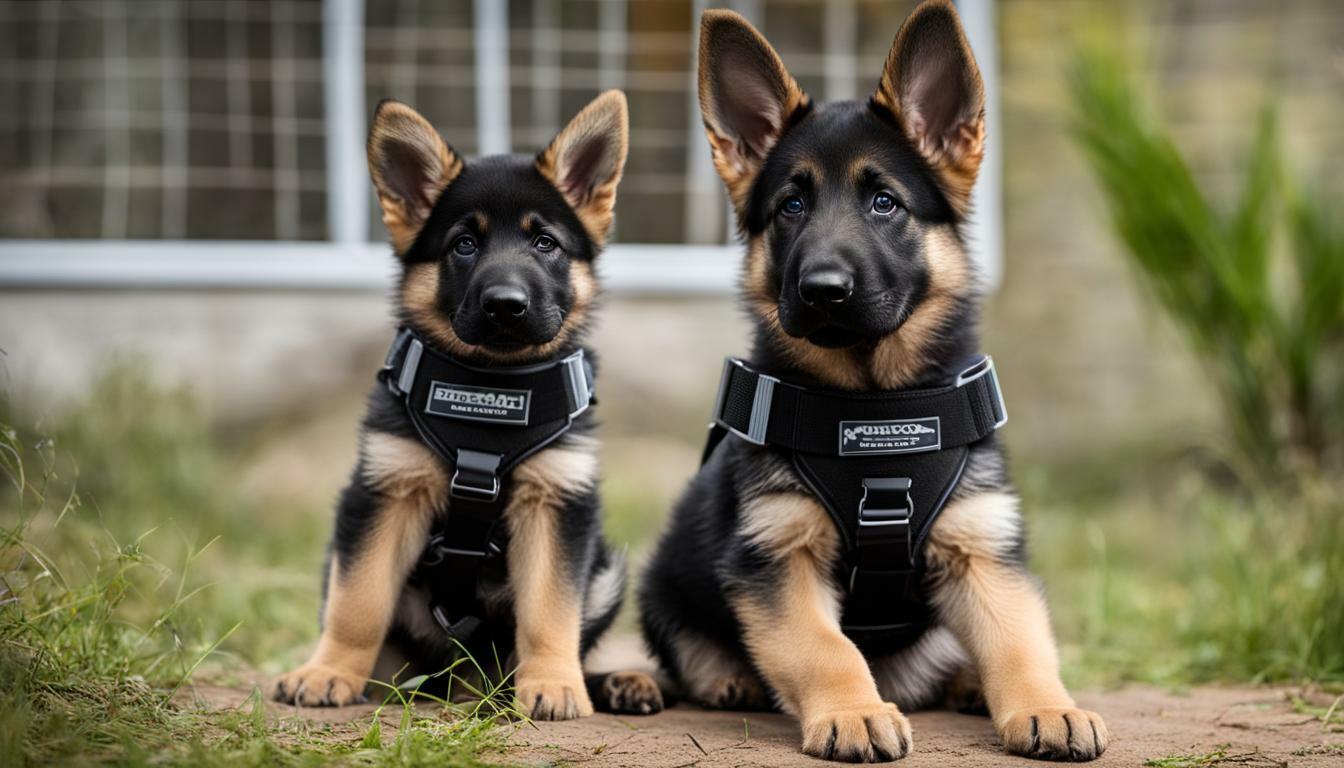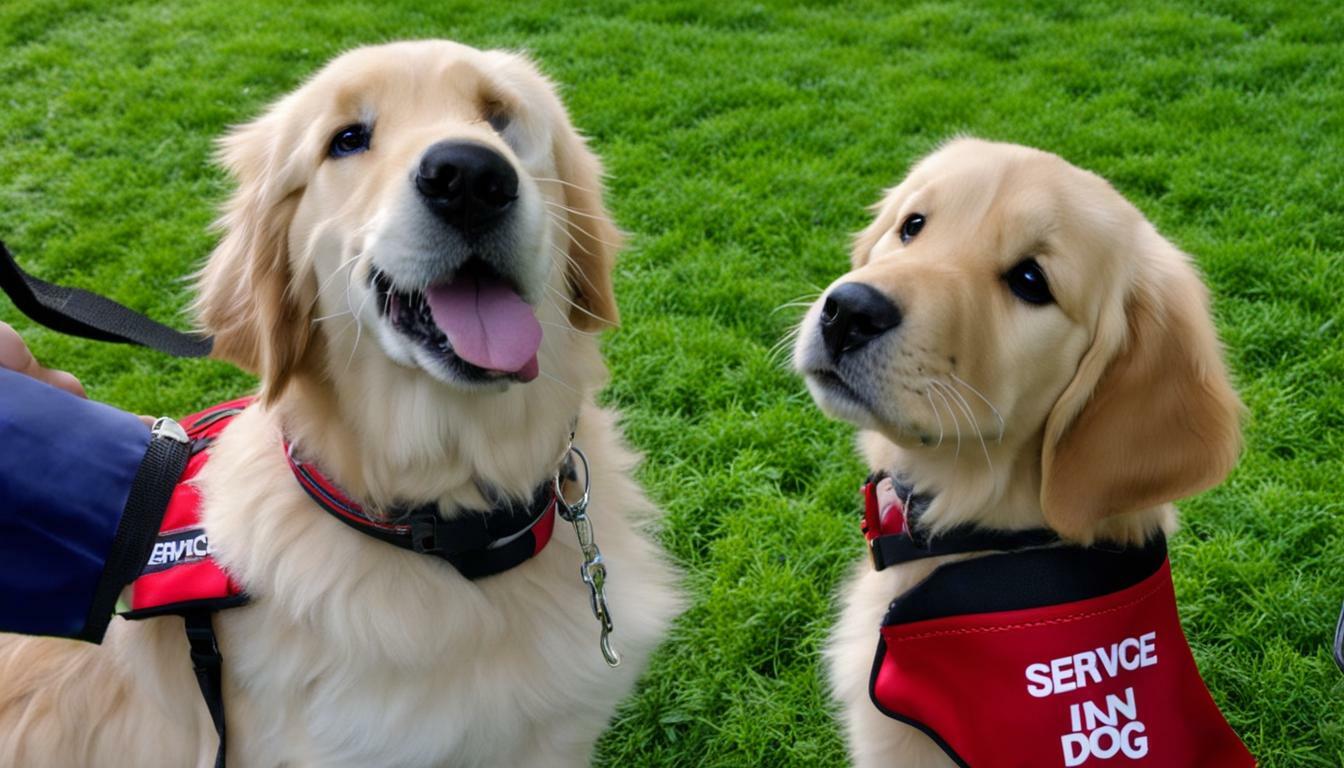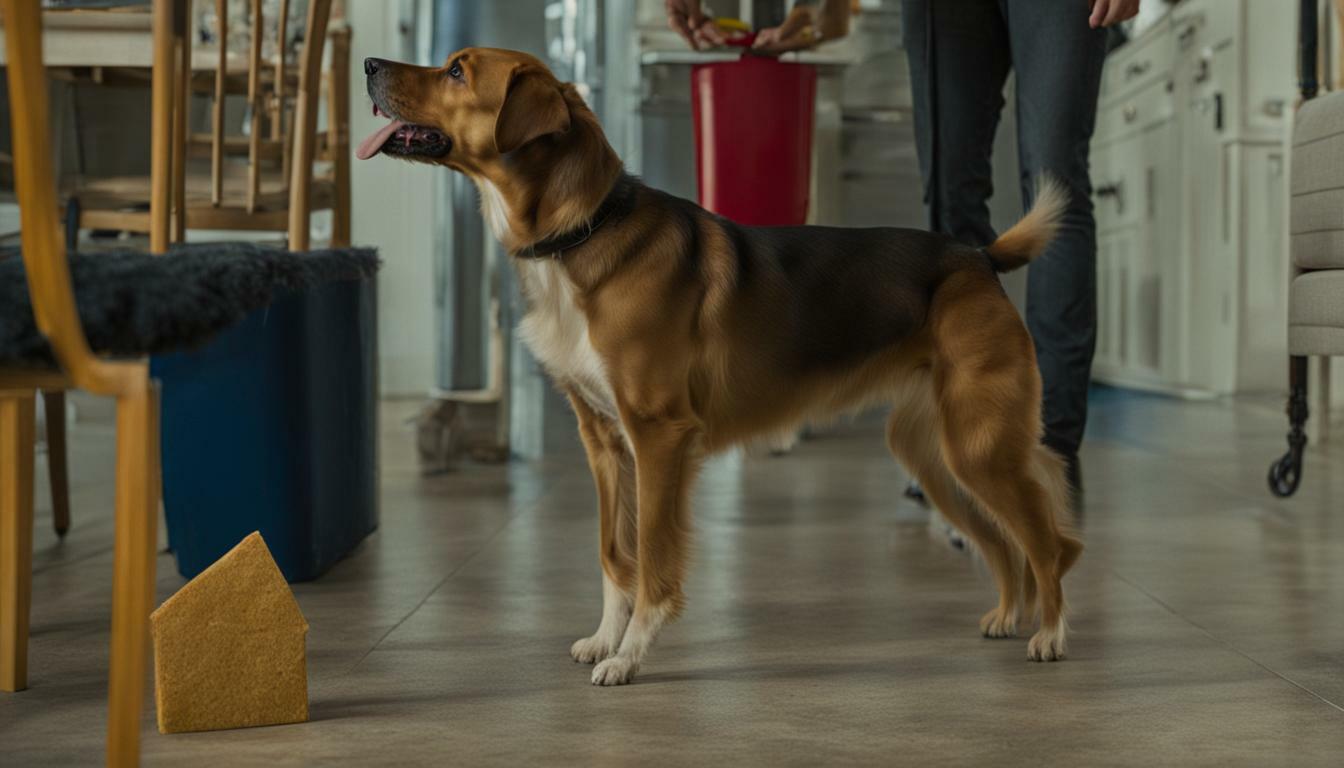Dog protection training is an essential aspect of ensuring the safety of your canine companion. Determining the right age to start this training can be crucial for harnessing their potential. It’s important to choose a breed with the right temperament and instincts for protection work. The training process involves teaching obedience, commands, and controlled aggression. The ideal age for protection training is during a dog’s adolescence, between 6 to 18 months old. Starting obedience training at a young age, around 8 weeks old, is crucial to establish a strong foundation. Testing a dog’s response to potentially threatening situations can help gauge their natural instincts. Overall, it is important to be patient, consistent, and positive throughout the training process.
Key Takeaways:
- Start dog protection training around 6 months old
- Choose a breed with the right temperament and instincts for protection work
- Teach obedience, commands, and controlled aggression during the training process
- The ideal age for protection training is between 6 to 18 months old
- German Shepherds, Rottweilers, Doberman Pinschers, Mastiffs, Cane Corsos, and Belgian Malinois are suitable breeds for protection training
Importance of Choosing the Right Breed for Protection Training
Not all dog breeds are suitable for protection training, making it essential to choose a breed with the right qualities and characteristics. When selecting a breed for protection training, it is important to consider their temperament, instincts, and physical capabilities. Certain breeds have a natural inclination for protective behaviors and can excel in this type of training.
German Shepherds are one of the most commonly chosen breeds for protection work. They are intelligent, loyal, and possess a strong protective instinct. Rottweilers are also well-regarded for their protective nature and make excellent guard dogs. Doberman Pinschers are known for their fearlessness and loyalty, making them a popular choice for protection training.
In addition to these breeds, Mastiffs, Cane Corsos, and Belgian Malinois also have the qualities that make them strong candidates for protection training. These breeds are known for their high levels of loyalty, intelligence, and natural instincts for guarding and protecting their families.
When choosing a breed for protection training, it is crucial to research and understand the specific characteristics and requirements of each breed. This will ensure that the selected breed is not only capable of protection work but also compatible with the owner’s lifestyle and needs. By selecting a breed with the right qualities, individuals can increase the chances of success in dog protection training.
| Breed | Temperament | Instincts |
|---|---|---|
| German Shepherds | Intelligent, Loyal | Strong Protective Instinct |
| Rottweilers | Fearless, Loyal | Protective Nature |
| Doberman Pinschers | Fearless, Loyal | Protective Nature |
| Mastiffs | Loyal, Courageous | Strong Guardian Instincts |
| Cane Corsos | Loyal, Brave | Natural Protector |
| Belgian Malinois | Smart, Energetic | Highly Protective |
Training Process for Dog Protection Training
Dog protection training involves a systematic process that includes obedience training, command instruction, and controlled aggression. It is essential to establish a strong foundation of obedience before moving on to more advanced training techniques. This can be started as early as 8 weeks old, when puppies are most receptive to learning. Obedience training teaches dogs to respond to basic commands such as sit, stay, and come, laying the groundwork for more complex maneuvers.
Once a solid obedience foundation is established, command instruction becomes the focus. This involves teaching the dog specific commands that will be used during protection work, such as “guard,” “release,” and “attack.” These commands should be taught gradually, using positive reinforcement techniques to ensure the dog understands their purpose and responds appropriately.
Controlled aggression is another crucial aspect of dog protection training. This involves teaching the dog to recognize threats and respond with confidence and controlled intensity. It is important to carefully balance aggression with obedience, ensuring that the dog understands when and how to use force, and only in situations where it is necessary to protect their handler or property.
| Training Process for Dog Protection Training |
|---|
| 1. Begin with obedience training, starting at 8 weeks old |
| 2. Teach specific commands for protection work |
| 3. Train controlled aggression, balancing it with obedience |
Know what tags to use while making a table, writing a paragraph, and creating a header. Ensure that the content flows logically and provides all the necessary information about the training process for dog protection. By following this systematic process, dog owners and trainers can help their dogs develop the skills and instincts necessary for effective protection work.
Ideal Age for Dog Protection Training
The ideal age to start dog protection training is during their adolescence, typically between 6 to 18 months old. This is a crucial period in a dog’s development when they are more receptive to learning and are developing both physically and mentally. By starting training at this age, you can ensure that your dog is well-prepared for their role as a protector and can maximize their potential.
During this phase, dogs have gained enough maturity to understand and follow commands, while still being flexible enough to adapt to new situations. They have also developed enough physical strength to handle the demands of protection work. By beginning training at this age, you can shape their behaviors and instincts, molding them into confident and reliable protectors.
To help guide their development, it is essential to provide them with a structured training program that focuses on obedience, teaching commands, and controlled aggression. Obedience training establishes the foundation for good behavior and control, while teaching commands enhances their ability to follow instructions. Controlled aggression training helps them understand when and how to protect, ensuring they respond appropriately to potential threats.
Breeds Suited for Protection Training
Not all breeds are suitable for protection training. Certain breeds have innate instincts and characteristics that make them more adept at this type of work. German Shepherds, Rottweilers, Doberman Pinschers, Mastiffs, Cane Corsos, and Belgian Malinois are recognized for their protective instincts, intelligence, and physical capabilities. These breeds have a natural inclination towards guarding and protecting, making them excellent candidates for protection training.
| Breed | Temperament | Instincts |
|---|---|---|
| German Shepherds | Loyal, confident, and trainable | Protective, territorial, and alert |
| Rottweilers | Fearless, calm, and obedient | Strong guarding and protective instincts |
| Doberman Pinschers | Vigilant, energetic, and intelligent | Natural protectors with high drive |
| Mastiffs | Gentle, patient, and loyal | Powerful and protective instincts |
| Cane Corsos | Confident, loyal, and protective | Guarding and territory instincts |
| Belgian Malinois | Alert, intelligent, and driven | Energetic and strong prey drive |
By selecting one of these breeds and starting their training during their adolescence, you can set your dog up for success in their protection training journey. Remember to be patient, consistent, and use positive reinforcement methods throughout the training process to build a strong bond of trust and respect with your dog. With the right breed, proper training, and a supportive environment, you can help your canine companion become a reliable protector.
Breeds Suited for Protection Training
Certain dog breeds are known for their suitability in protection training, including German Shepherds, Rottweilers, Doberman Pinschers, Mastiffs, Cane Corsos, and Belgian Malinois. These breeds possess the necessary traits and instincts to excel in protective roles.
German Shepherds
German Shepherds are widely recognized as one of the best breeds for protection training. They are intelligent, loyal, and possess a strong protective instinct. Their versatility allows them to excel in various roles, including police, military, and personal protection.
Rottweilers
Rottweilers are powerful and confident dogs, making them excellent candidates for protection training. With proper training and socialization, they can become loyal family companions while maintaining their protective nature. Their natural guarding instincts and strength make them highly effective in security roles.
Doberman Pinschers
Doberman Pinschers are known for their high energy and intelligence. They are quick learners and respond well to proper training techniques. Their natural instinct to protect their family combined with their athleticism makes them suitable for protection work.
Mastiffs, Cane Corsos, and Belgian Malinois
Mastiffs possess a calm and steady temperament, which makes them dependable protectors. Cane Corsos are known for their natural guarding instincts and loyalty. Belgian Malinois are highly intelligent and have a strong drive to work, making them exceptional in protection roles.
| Breed | Traits |
|---|---|
| German Shepherds | Intelligent, loyal, versatile |
| Rottweilers | Powerful, confident, protective |
| Doberman Pinschers | High energy, intelligent, protective |
| Mastiffs | Dependable, calm, steady |
| Cane Corsos | Natural guarding instincts, loyal |
| Belgian Malinois | Highly intelligent, strong work drive |
Importance of Early Obedience Training
Early obedience training is crucial for setting a solid foundation for dog protection training, starting as early as 8 weeks old. At this age, puppies are in a critical developmental stage, where they are highly receptive to learning and forming habits. By introducing basic obedience commands such as sit, stay, and come, owners can establish clear communication with their furry companions.
Consistency is key when it comes to obedience training. By consistently reinforcing desired behaviors and promptly redirecting unwanted behaviors, puppies learn what is expected of them. This consistency helps them build positive associations with training sessions and encourages them to respond to commands reliably.
Positive reinforcement is a powerful tool in early obedience training. Rewarding puppies with treats, praise, or playtime when they exhibit desired behaviors helps to reinforce those behaviors. This positive approach fosters a sense of trust and strengthens the bond between the owner and the puppy. It also encourages puppies to actively engage in training sessions and enhances their overall learning experience.
Table: Basic Obedience Commands
| Command | Description |
|---|---|
| Sit | The puppy sits down on command, with their bottom on the ground. |
| Stay | The puppy remains in their position until given a release command. |
| Come | The puppy comes to the owner when called. |
| Leave it | The puppy refrains from touching or grabbing something when instructed. |
| Drop it | The puppy releases an object from their mouth when told to do so. |
In conclusion, early obedience training sets the foundation for successful dog protection training. Starting as early as 8 weeks old allows puppies to learn essential commands, develop good behaviors, and establish a strong bond with their owners. By being consistent, using positive reinforcement, and teaching basic commands, owners can lay the groundwork for a well-trained and well-behaved protection dog in the future.
Evaluating Natural Instincts and Response
Assessing a dog’s response to potential threats is an essential step in determining their suitability for protection training. It is crucial to ensure that a dog has the necessary instincts and reactions to effectively protect their owner or property. This evaluation process helps identify dogs with the right temperament and potential for success in protection work.
During the evaluation, trainers expose the dog to various scenarios that simulate potential threats or dangerous situations. This could include encounters with strangers, unfamiliar sounds, or sudden movements. Observing the dog’s natural instincts and response will provide valuable insights into their ability to handle and react appropriately in challenging situations.
Trainers carefully observe the dog’s behavior, looking for signs of confidence, alertness, and the ability to assess potential threats. A well-suited protection dog should display a strong willingness to protect their owner or territory, without being overly aggressive or fearful. It is important to note that training and socialization play a significant role in shaping a dog’s behavior, but natural instincts are the foundation upon which their protective abilities are built.
| Potential Threats | Dog’s Response |
|---|---|
| Approaching strangers | Awareness and vigilance |
| Unfamiliar sounds | Alertness and curiosity |
| Sudden movements | Quick reaction time |
By evaluating a dog’s response to potentially threatening situations, trainers can make informed decisions about their suitability for protection training. Dogs that demonstrate the desired instincts and responses can then undergo further training to develop their skills and abilities. Remember, every dog is unique, and proper evaluation is essential to ensure a good fit between the dog and the training program.
Key Tips for Dog Protection Training
Successful dog protection training requires patience, consistency, and positive reinforcement as essential components. It is important to approach the training process with a calm and composed demeanor, as dogs can sense your emotions and will respond better to a relaxed and confident handler.
Consistency is key when it comes to dog protection training. Establish a routine and stick to it, ensuring that training sessions are conducted at the same time and in the same location. This helps create a sense of structure and reliability for your dog, allowing them to better understand what is expected of them.
Positive reinforcement is a powerful tool in dog training. By rewarding your dog with treats, praise, and affection when they exhibit the desired behavior, you create a positive association and motivate them to continue performing well. Avoid punishment or harsh training methods, as they can damage the trust and bond between you and your dog.
Creating a Training Plan
To maximize the effectiveness of your dog protection training, it is beneficial to create a comprehensive training plan. Start by setting clear goals and objectives for each training session, focusing on specific skills or commands you want your dog to learn. Break down the training into small, manageable tasks, gradually increasing the difficulty as your dog becomes more proficient.
| Key Tips | Benefits |
|---|---|
| Break down training into short sessions | Helps maintain focus and prevents burnout |
| Use high-value treats as rewards | Increase motivation and reinforce positive behavior |
| Practice in different environments | Ensures that your dog can perform in various settings |
Remember, dog protection training is a gradual process that requires time, effort, and dedication. Celebrate small successes along the way and be patient with your dog as they learn and grow. With consistent and positive training methods, you can help shape your dog into a confident and reliable protector.
Conclusion
Starting dog protection training at the appropriate age is crucial for harnessing their potential and ensuring their safety. Determining the right age to begin this type of training can be challenging, but it is generally recommended to start when the dog is around 6 months old. This allows them to mature physically and mentally, making it easier for them to grasp the concepts and commands involved in protection training.
When considering dog protection training, it is important to choose a breed with the right temperament and instincts for this type of work. Breeds such as German Shepherds, Rottweilers, Doberman Pinschers, Mastiffs, Cane Corsos, and Belgian Malinois are known for excelling in protection training due to their natural protective instincts and strong drive to defend their families.
The training process for dog protection training involves teaching the dog obedience, commands, and controlled aggression. Starting obedience training at a young age, around 8 weeks old, is crucial to establish a strong foundation for further training. This early training helps develop discipline, focus, and responsiveness, which are essential qualities for a successful protection dog.
Evaluating a dog’s natural instincts and response to potentially threatening situations is also important in the training process. This assessment can help determine if the dog has the right temperament and drive for protection work. It is essential to gauge their reactions and ensure they can handle the intensity and pressure associated with protection training.
Throughout the training process, it is vital to be patient, consistent, and positive. Dogs respond best to reward-based training methods that motivate and encourage them. By maintaining a calm and positive demeanor, trainers can build a strong bond with their dogs, creating a solid foundation for successful protection training.
In conclusion, the optimal age to start dog protection training is during a dog’s adolescence, between 6 to 18 months old. By choosing the right breed, starting early obedience training, evaluating natural instincts, and practicing patience and consistency, owners can set their dogs up for success in protection work. With the appropriate training and guidance, dogs can become reliable protectors and loyal companions.
FAQ
What is the recommended age to start dog protection training?
Determining the age to start dog protection training can be challenging, but it is generally recommended to start when the dog is around 6 months old.
Why is it important to choose the right breed for protection training?
Choosing a breed with the right temperament and instincts for protection training is crucial to ensure success in the training process.
What does the training process for dog protection training involve?
The training process for dog protection training includes teaching obedience, commands, and controlled aggression to develop the necessary skills for protection work.
At what age is the ideal time to start dog protection training?
The ideal age for dog protection training is during a dog’s adolescence, between 6 to 18 months old.
Which breeds are well-suited for protection training?
German Shepherds, Rottweilers, Doberman Pinschers, Mastiffs, Cane Corsos, and Belgian Malinois are breeds known for their suitability for protection training.
How important is early obedience training?
Starting obedience training at a young age, around 8 weeks old, is crucial to establish a strong foundation for dog protection training.
How can natural instincts and response be evaluated for dog protection training?
Evaluating a dog’s response to potentially threatening situations can help gauge their natural instincts and suitability for protection training.
What are some key tips for dog protection training?
Patience, consistency, and positive reinforcement are key tips for successful dog protection training.

Marissa Delotta, 36, from Dayton, Ohio, is the creative force behind Roverboard.com, a beloved online destination for dog lovers. As a dedicated mom and canine enthusiast, Marissa combines her family experiences with her love for dogs to offer a platform where dog owners can exchange tips, heartwarming stories, and advice. Her website has become a vibrant community for sharing the joys of dog parenting. In her free time, Marissa enjoys exploring dog parks with her family and volunteering at local animal shelters.





